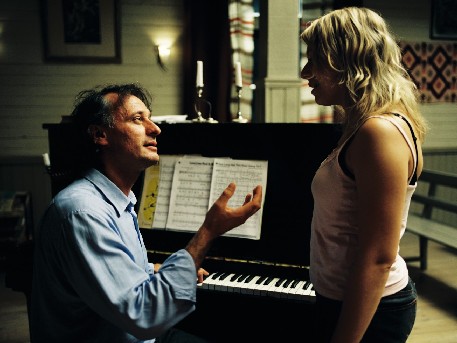Film Friday
Every once in a while I see a film that makes the world seem so resonant and filled with meaning that I find myself moving through a haze for a day or two afterwards. Often the films that have this effect are about hearts opening, grace descending, a wasteland being regenerated. Such a film is As It Is in Heaven, a 2005 Oscar-nominated Swedish film that I watched last week through Netflix’s live streaming. Be warned that there are spoilers in the following essay.
The film is about a violinist/conductor, Daniel Daréus, who is bullied as a child so that his single mother, whom he adores, moves them to another town. Then, as an adolescent, he loses her when she is run down by a car. These traumatic events, which we see as flashbacks in the opening minutes of the film, haunt his musical career, turning him into a brilliant but driven conductor who is in demand all over the world. His career is suddenly cut short, however, when he has a heart attack and must retire while still relatively young.
He returns, for reasons that he does not understand, to the small town where he was bullied. He buys the old school building and plans simply to “listen.” Unexpectedly, he finds himself conducting the church choir and sets out to achieve a dream where all the members will be so open to the music that is around and within them that they won’t need sheet music. He tries various unconventional techniques, some of them involving trust-building exercises, and manages to frighten one choir member and the repressed minister.
The members of the choir, however, find themselves opening up in new and powerful ways. One woman, who is in an abusive marriage, finds such strength through a solo that Daniel writes specially for her that she leaves her husband. An overweight man stands up to a fellow choir member who has long been deriding him. Another man confesses his hidden love for a woman after decades of silence. The wife of the preacher—he is one of those inwardly tormented types that are always showing up in Bergman movies—seeks to inject love back into their marriage although in this she is unsuccessful.
Daniel must also learn to open up—he realizes that he has returned to the town to confront his unresolved sadness over his mother—and he finds love, both in the angelic Lena and in the community as a whole. His heart problems have not gone away, however, and in the end, when his choir is set to perform in a singing competition in Austria, he has a fatal heart attack and the choir, not knowing where he is, must go on without him.
Panicked at first, they begin singing individual notes—each member channeling his or her own voice—and the harmony that emerges proves so powerful that all the other choirs in the hall find themselves joining in so that it is no longer a competition (the world of competitive music is what ground Daniel down) but a spontaneous liberation of the music. A vision that Daniel describes earlier in the film—how once, when he was directing, the concert hall lost power so that for 59 seconds the orchestra performed together in the darkness as a single being—comes to pass.
Dying in a bathroom, Daniel hears the music through the intercom and is carried back to the moment when his mother found him in a wheat field after he had been beaten by the bullies. He dies peacefully.
We also see this wheat field, waving in the wind and towering over the child’s head, in the opening scene. Daniel is practicing his violin and his music, clipped to wheat stalks, sways before him. This startling image also ties into the broader theme, that there is a force blowing through the universe that we can access if we open ourselves to it. In the film, the townspeople are able to use music to work through their angers, their petty jealousies, their repressed loves, their dysfunctional relationships. By the end, they are harmonizing “Amazing Grace” and “Down by the Riverside” and the battered woman is singing, “I want to feel that I have lived my life.”
It was only after I had watched the film that I realized that it is structured upon Jesus’s story. Seen through this lens, Daniel is Jesus, the pastor is the Sadducees, and the wife beater (who at one point beats Daniel up so that he lies in the water in a crucified position) is the Romans. In the choir, there is a Peter (the pushy promoter), a Judas (a woman spying for the pastor), a “best beloved” (the angelic Lena), and a Mary Magdalene figure (Gabrielle). There is a scene where Daniel is nursed back to health by three women (the Pieta), and one could say that at the end the film merges the Ascension and Pentecost: the Holy Spirit descends upon the choir as Daniel dies (or, as he sees it, ascends to his mother). Indeed, the rich field of wheat that opens and closes the film is the seed that fell on fertile ground.
But I interpret the film in this light, not to reduce it to an allegory (which makes it sound mechanical), but to help me understand why the film opened me up as it did. I knew, watching it, that grace had descended and only in retrospect realized that it invokes another story of amazing grace. The two stories build on each other.


